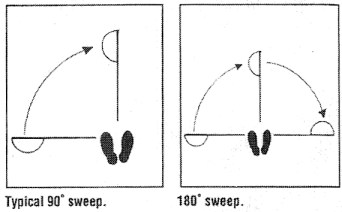Monitoring Insects Using A Sweep Net
For insects such as lygus bugs, some aphids, and beneficial insects, calculating the number of insects per sweep with a sweep net may be the preferred sampling technique. Some insects, such as lygus bugs, are very mobile, and hard to monitor any other way.
Use the following procedure to monitor insects with a sweep net:
- Determine the appropriate number of sweep to take at each site. A sweep is made by swinging the net through the crop canopy so the top of the net is at crop height. If there is et canopy or the crop is short, sweep close to the ground. One sweep can be either a 90 or 180 pass through the crop, Take at least one complete step forward between sweeps so the sweeping activity does net influence the catch in your next sweep 180°

- At the end of the last sweep, immediately swing the net quickly back and forth through the air well above the canopy to force the insects to the bottom of the net.
- Quickly grab the bag about 15 to 20cm from the bottom to confine the insects and prevent escape.
- At this point, many people prefer to invert the net through the rim of the net, while still holding the net closed, then slowly open the portion of the net containing the insects. Insects can then be counted as they escape from the net.
Another option, once the portion of the net where the insects are trapped has been inverted through the rim of the net, is to empty the insect, into a plastic bag or bottle. The counting system you adopt will depend on how well and quickly you can identify the insects in your net, the number of species present and the total number of specimens. In situations where large numbers of insects make counting difficult in the field, consider placing the contents into a plastic bag, and sea[ and store for counting later. Successful counts of large numbers can be made by placing the bags in the freezer for 30 minutes to slow the insects down to allow for counting.

